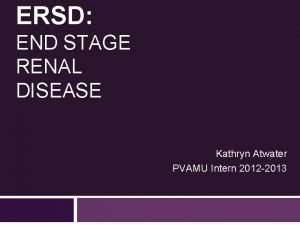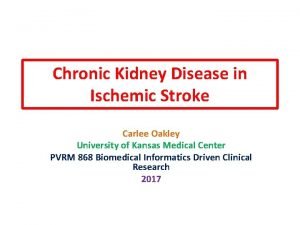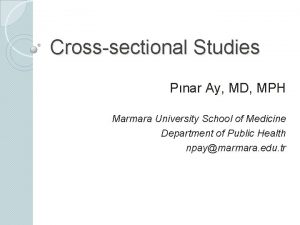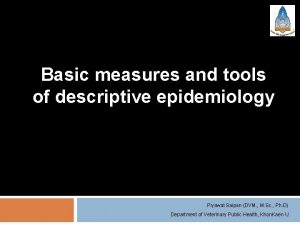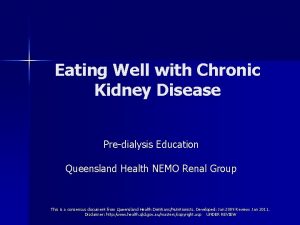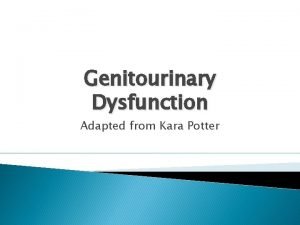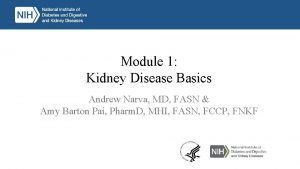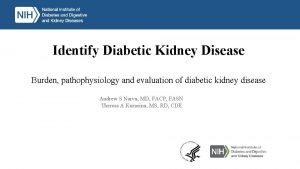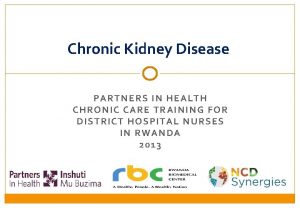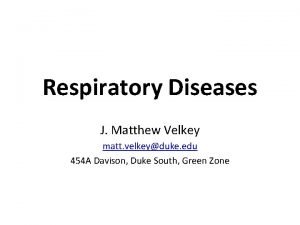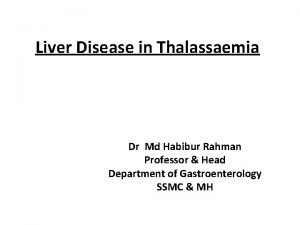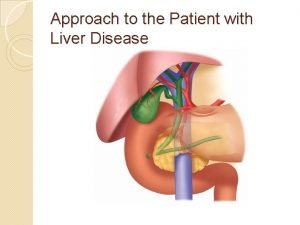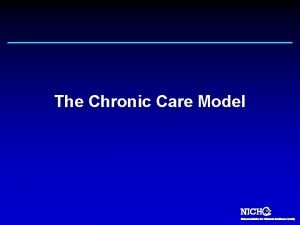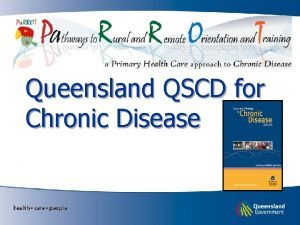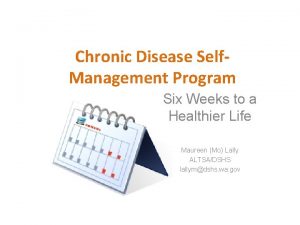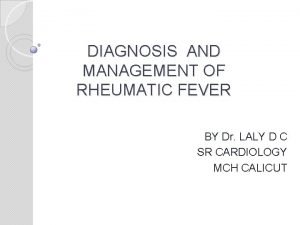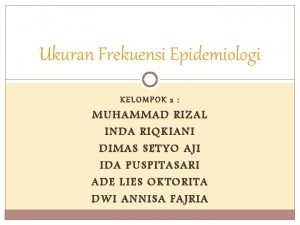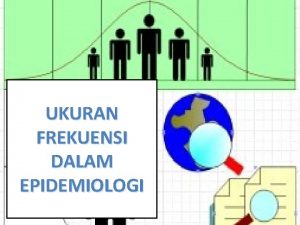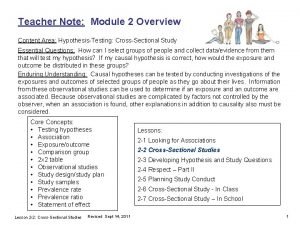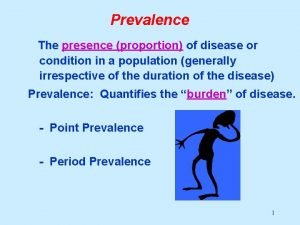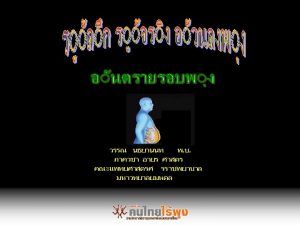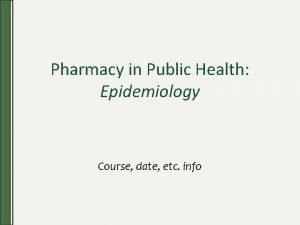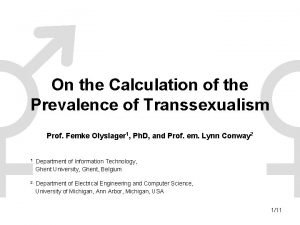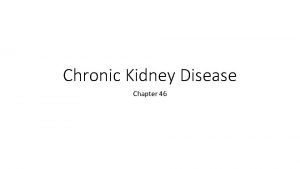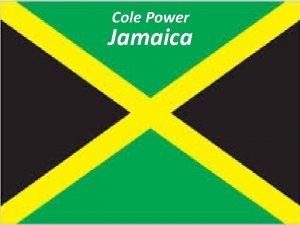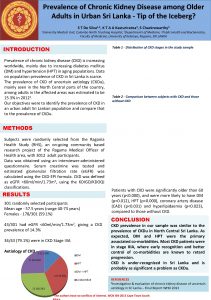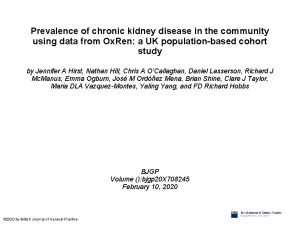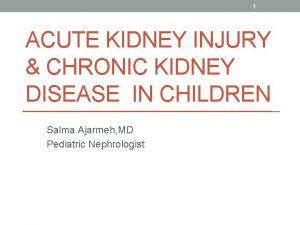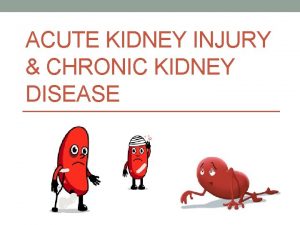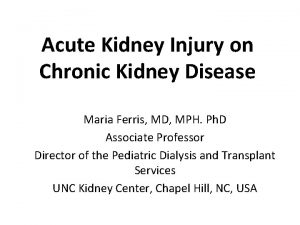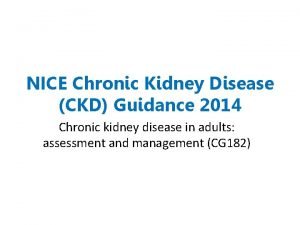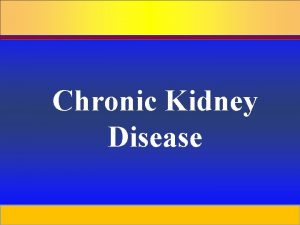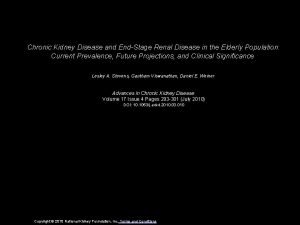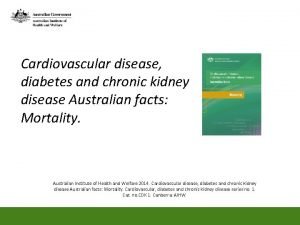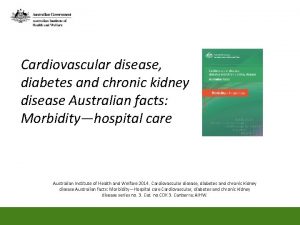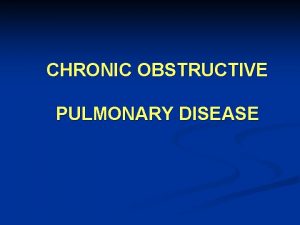Prevalence of Chronic Kidney Disease in Jamaica National






































- Slides: 38

Prevalence of Chronic Kidney Disease in Jamaica: National Estimates from the Jamaica Health and Lifestyle Survey 2016 -2017 Trevor S Ferguson, MBBS, DM, MSc, FACP, FRCP Edin Senior Lecturer (Epidemiology), Caribbean Institute for Health Research, UWI; Honorary Consultant (General Internal Medicine), UHWI Caribbean Institute of Nephrology ; 12 th Annual International Conference on Nephrology and Hypertension; January 23 -24, 2020 THE UNIVERSITY OF THE WEST INDIES | CAIHR www. uwi. edu/caihr

INTRODUCTION • Chronic Kidney disease (CKD) is a heterogeneous group of disorders characterized by alterations in kidney structure and function • In 2012, the KDIGO Guidelines defines CKD as: • GFR <60 ml/min/1. 73 m 2 OR • Markers of kidney damage AND • Abnormalities present for duration > 3 months *KDIGO = Kidney Disease Improving Global Outcomes References: Levy et al. Definition and staging of chronic kidney disease in adults. Up. To. Date 2018 KDIGO Work Group: Definition and classification of CKD; Kidney International Supplements (2013) 3, 19 -62 2 www. uwi. edu/caihr

INTRODUCTION • Markers of kidney damage include: • Albuminuria • Abnormal urinary sediments • Renal tubular disorders • Histological abnormality on renal biopsy • Structural abnormalities on renal imaging Kidney International Supplements (2013) 3, 19 -62 3 www. uwi. edu/caihr

CKD Staging and Risk Categories KDIGO recommended classification and staging of CKD based on • Cause • GFR • Albuminuria Risk Category Grid • Green: low risk • Yellow: moderately increased risk • Orange: high risk • Red: very high risk Source: Kidney International Supplements (2013) 3, 19 -62 4 www. uwi. edu/caihr

INTRODUCTION CKD is associated with a range of adverse outcomes including: • Increased all-cause mortality • Cardiovascular disease • Progression to end stage renal disease • Acute kidney injury • Anaemia • Cognitive decline 5 www. uwi. edu/caihr

EPIDEMIOLOGY • CKD is now recognized as a global public health problem • In 2013, worldwide prevalence was as estimated to be between 8% - 16%, with a prevalence of 11. 5% in the United States • In a 2016 paper, Hill and colleagues conducted a systematic review and meta-analysis of 100 published studies with over 6 million participants and estimated CKD prevalence of 13. 4% (95% CI 11. 7 -15. 1%) References: Jha et al. Chronic kidney disease: global dimension and perspectives. Lancet 2013; 382: 260– 72 Hill et al. Global Prevalence of Chronic Kidney Disease – A Systematic Review and Meta-Analysis. PLo. S ONE 2016; 11 (7): e 0158765. 6 www. uwi. edu/caihr

EPIDEMIOLOGY • The Global Burden of Disease study, in 2015, estimated that 1. 2 million deaths, 19 million DALYs and 18 million years of life lost from CVDs were directly attributable to reduced GFR • Also estimated that 1. 2 million people died from kidney failure in 2015, an increase of 32% since 2005 • Additionally, each year, around 1. 7 million people are thought to die from acute kidney injury • These data clearly support the view that CKD is a major problem Source: Luyckx et al. The global burden of kidney disease and the sustainable development goals. Bull World Health Organ 2018; 96: 414– 422 C www. uwi. edu/caihr

EPIDEMIOLOGY • In Jamaica, the prevalence of chronic renal failure was estimated at 327 per million in 1999 (CRF was defined as serum creatinine >150 µmol/L) • Latest figures from the Caribbean Renal Registry • 2700 patients at different CKD stages in Jamaica (data from 4 main parishes) • More than 800 receiving dialysis • 1200 anticipated to need some sort of renal replacement therapy in the future References: Barton et al. A survey of chronic renal failure in Jamaica. West Indian Med J 2004; 53: 81– 4. Kramer et al. The burden of chronic kidney disease and its major risk factors in Jamaica Kidney International (2018) 94, 840– 842; 8 www. uwi. edu/caihr

Causes of CKD • Diabetes mellitus is most frequent cause of CKD in North America and Europe • In Jamaica hypertension is the most common cause of CRF/ESRD, followed by diabetes mellitus References: Chronic Kidney Disease; Harrison’s Online www. accessmedicine. com West Indian Med J 2007: 56(4): 355 -362 9 www. uwi. edu/caihr

Causes of Kidney Disease in Jamaica 40. 0% 35. 2% 35. 0% 29. 7% 30. 0% 25. 0% 21. 3% 20. 0% 15. 0% 10. 0% 6. 9% Glomerulonephritis Lupus 5. 0% 0. 0% Hpertension Diabetes Others Source: Soyibo and Barton. West Indian Medical Journal 2009 10 www. uwi. edu/caihr

Prevalence of CKD in Jamaica (1) UHWI Diabetic Foot Study • Evaluated 132 patients from UHWI Diabetes clinic between September 2009 and August 2010 • Main objective was to estimate prevalence of diabetic foot complications, particularly amputations • Also measured urine albumin excretion and recorded serum creatinine from patient records • Mean age was 55. 4 years and mean duration of diabetes 16. 7 years Ferguson et al. Prevalence of Chronic Kidney Disease among Patients Attending a Specialist Diabetes Clinic in Jamaica. West Indian Med J 2015; 64 (3): 201 -208 11 www. uwi. edu/caihr

Prevalence of Decreased GFR – UHWI Diabetic Foot Study 25. 0 20. 0 23. 0 22. 0 18. 8 15. 0 Men % Women 10. 0 Total 5. 0 0. 0 Men Women Total Sex difference not significant Reduced GFR defined as <60 ml/min/1. 73 m 2 Estimated using CKD-EPI equation Ferguson et al. Prevalence of Chronic Kidney Disease among Patients Attending a Specialist Diabetes Clinic in Jamaica. West Indian Med J 2015; 64 (3): 201 -208 12 www. uwi. edu/caihr

Distribution of Albuminuria Categories 70. 0 63. 0 59. 4 60. 0 62. 1 50. 0 40. 0 % 30. 0 20. 0 <30 mg/g 30 -300 mg/g 28. 1 23. 0 12. 5 17. 4 14. 0 20. 5 >300 mg/g 10. 0 Men Women Total Sex difference not significant Ferguson et al. Prevalence of Chronic Kidney Disease among Patients Attending a Specialist Diabetes Clinic in Jamaica. West Indian Med J 2015; 64 (3): 201 -208 13 www. uwi. edu/caihr

Overall Prevalence of CKD Men Women Overall 78. 1 63. 4 -92. 8 89. 0 (82. 8 -95. 2) 86. 3 (80. 4 -92. 2) Sex difference not significant Ferguson et al. Prevalence of Chronic Kidney Disease among Patients Attending a Specialist Diabetes Clinic in Jamaica. West Indian Med J 2015; 64 (3): 201 -208 14 www. uwi. edu/caihr

Prevalence of CKD in Jamaica (2) - The 1986 Jamaica Birth Cohort • 744 participants from the 1986 Jamaica Birth Cohort • Subgroup of participants from Jamaica Perinatal Mortality Survey - born in Jamaica in September or October 1986 • Included participants from Kingston, St Andrew and St Catherine • 18 -20 years old at the tile of assessment • Estimated glomerular filtration rate (e. GFR) calculated using the Schwartz-Lyon equation • CKD defined as e. GFR < 60 ml/minute/1. 73 m 2 or urinary albumin ≥ 30 mg/g creatinine Rocke et al. Relationship between Early Life Factors and Renal Function in Afro-Caribbean Young Adults: Analysis from the Jamaica 1986 Birth Cohort Study. West Indian Med J 2018; 67 (2): 165 -172 15 www. uwi. edu/caihr

Prevalence of Renal Function Abnormalities by Sex Male 10 9 8 7 6 % 5 4 3 2 1 0 Female 9. 1 8. 9 7. 4 4. 7 3. 5 0. 2 Low e. GFR** Albuminuria Overall CKD 8. 3% (95%CI 6. 6%-10. 6%) CKD *p<0. 05 **P<0. 01 Rocke et al. Relationship between Early Life Factors and Renal Function in Afro-Caribbean Young Adults: Analysis from the Jamaica 1986 Birth Cohort Study. West Indian Med J 2018; 67 (2): 165 -172 16 www. uwi. edu/caihr

Prevalence of CKD in Jamaica (3) JHLS-III First opportunity to provide national prevalence estimated for CKD in Jamaica www. uwi. edu/caihr

JHLS-III Study Design n JHLS-III is a community-based interviewer-administered health examination survey of Jamaicans 15 years and older n Conducted between 2016 -2017 n Sampling was designed to be nationally representative n Multi-stage sampling procedure 1. Enumeration districts (EDs) were randomly selected, stratified by parish 2. Within EDs - systematic sampling to select 20 households 3. Within households - one participant selected using Kish method Jamaica Health and Lifestyle Survey (JHLS) III 2016 - 2017

Measurements n Serum creatinine measured at UHWI Chemical Pathology lab using a Cobas c 111 analyzer (Roche) n e. GFR calculated using CKD-EPI equation for Blacks n Categorised G 1 -G 5 based on KDIGO 2012 guidelines Source: https: //www. niddk. nih. gov/health-information/communication-programs/nkdep/laboratoryevaluation/glomerular-filtration-rate/estimating Jamaica Health and Lifestyle Survey (JHLS) III 2016 - 2017

Measurements n n n Urine albumin excretion – point of care urine dipstick - Micral test strip (Roche Diagnostics) Semi-quantitative test – Values reported as negative, 20 mg/L, 50 mg/L, 100 mg/L For this analysis we defined albuminuria as ≥ 50 mg/L (although the manufacturers recommended 20 mg/L as cut off for albuminuria) Jamaica Health and Lifestyle Survey (JHLS) III 2016 - 2017

CKD Definition n CKD defined as 2 n Reduced e. GFR (<60 m/min/1. 73 m ) OR n Albuminuria (mircoalbumin >=50 mg/L) n n Analyses limited to those who had data on both urine albumin excretion and e. GFR Also assessed: n Self reported history of kidney disease n Awareness of kidney disease Jamaica Health and Lifestyle Survey (JHLS) III 2016 - 2017

Statistical Methods (1) n Analyses used sampling weights based on n Probability of selection of dwellings and EDs, with n Adjustments for unit non-response, and n n Calibrated using population distribution in sexspecific 5 -year age bands at parish-level Weighting ensures that the findings can be generalised to Jamaican population of 15 years and older Jamaica Health and Lifestyle Survey (JHLS) III 2016 - 2017

Statistical Methods (2) n n Analyses performed using Stata statistical software Obtained means and proportions weighted for survey design Assessed differences by sex and age categories, and by presence of diabetes mellitus or hypertension Full JHLS-III sample included 2807 participants, but analyses were restricted to those with data on renal outcomes Jamaica Health and Lifestyle Survey (JHLS) III 2016 - 2017

Number of Participants in Analysed Sample 1200 1000 800 600 400 200 0 Total Male Female e. GFR 1161 431 730 Total Albuminuria 722 266 456 Male CKD 669 247 422 Female www. uwi. edu/caihr

Characteristics of the Sample by Sex Characteristics Age (years) BMI (kg/m 2) SBP (mm. Hg) DBP (mm. Hg) Males n = 431 mean (95% CI) Females n = 730 mean (95% CI) Both Sexes N = 1161 mean (95% CI) 45. 7 43. 3 44. 4 (44. 0, 47. 4) (42. 1, 44. 5) (44. 3, 45. 6) 26. 2 30. 1 28. 2 (25. 0, 27. 4) (29. 3, 31. 0) (27. 5, 29. 0) 132. 1 126. 1 129. 0 (130. 3, 133. 9) (124. 1, 128. 1) (127. 6, 130. 4 83. 1 82. 7 (81. 7, 84. 4) (81. 2, 84. 1) (81. 8, 87. 9) e. GFR = estimated Glomerular Filtration Rate. e. GFR was calculated using the Chronic Kidney Disease Epidemiology Collaboration (CKD-EPI) equation. www. uwi. edu/caihr

Mean Values of Serum Creatinine and Estimated Glomerular Filtration Rate by Sex Renal Outcome Serum Creatinine ( mol/l) *** e. GFR (ml/min/1. 73 m 2) *** Males mean (95% CI) Females mean (95% CI) Both Sexes mean (95% CI) 97. 4 77. 4 87. 1 (94. 8, 100. 0) (73. 7, 81. 2) (84. 9, 89. 4) 99. 4 104. 5 102. 0 (97. 7, 101. 1) (102. 3, 106. 6) (100. 6, 103. 5) e. GFR = estimated Glomerular Filtration Rate. e. GFR was calculated using the Chronic Kidney Disease Epidemiology Collaboration (CKD-EPI) equation. www. uwi. edu/caihr

Prevalence of Selected Renal Indices by Sex Males % Females % Both Sexes % Albuminuria * (urine albumin ≥ 50 mg/L) 10. 3 14. 2 12. 4 Reduced GFR * (e. GFR < 60 ml/min/1. 73 m 2) 3. 2 4. 9 4. 1 Chronic Kidney Disease ** (reduced GFR or albuminuria) 12. 4 17. 6 15. 2 Kidney failure (e. GFR < 15 ml/min/1. 73 m 2) 0. 2 0. 5 0. 3 Renal Outcome 15% prevalence of CKD indicates 220, 000 persons 18 years and older www. uwi. edu/caihr

Distribution of GFR Categories by Sex 100. 0 80. 0 60. 0 % 40. 0 20. 0 GFR <15 GFR 15 -29 GFR 30 -44 GFR 45 -59 GFR 60 -89 GFR ≥ 90 Male 0. 2 0. 1 0. 5 2. 5 33. 2 63. 6 GFR 60 -89 Female 0. 5 0. 1 1. 0 3. 4 25. 3 69. 8 GFR 45 -59 GFR 30 -44 Total 0. 3 0. 1 0. 7 3. 0 29. 1 66. 8 GFR 15 -29 GFR <15 P <0. 01 for sex difference www. uwi. edu/caihr

Distribution of Albuminuria Categories by Sex 100. 0 80. 0 % 60. 0 40. 0 20. 0 100 mg/l 50 mg/l 20 mg/l Negative Male 5. 3 5. 1 56. 8 32. 9 Negative Female 4. 4 9. 8 57. 0 28. 8 20 mg/l 50 mg/l Total 4. 8 7. 5 56. 9 30. 7 100 mg/l www. uwi. edu/caihr

Prevalence of Selected Renal Indices by Age Category Renal Outcome Albuminuria *** (urine albumin ≥ 50 mg/l) Reduced GFR *** (e. GFR < 60 ml/min/1. 73 m 2 ) Chronic Kidney Disease *** (reduced GFR or albuminuria) Kidney failure ** (e. GFR < 15 ml/min/1. 73 m 2 ) 18 -24 years % 25 -34 years % 35 -44 years % 45 -54 years % 55 -64 years % 65 -74 years % ≥ 75 years % 6. 6 12. 0 11. 2 10. 7 19. 2 21. 3 16. 8 3. 0 1. 0 0. 2 1. 5 6. 3 9. 6 28. 9 8. 0 11. 5 10. 2 11. 7 25. 2 28. 1 43. 5 - 1. 0 - - 0. 8 0. 4 - www. uwi. edu/caihr

Prevalence of Selected Renal Indices among persons with and without hypertension and diabetes mellitus Hypertensive % Not Hypertensive % Diabetic % Not Diabetic % Albuminuria (urine albumin ≥ 50 mg/l) 19. 3 *** 8. 3 19. 8 *** 11. 4 Reduced GFR (e. GFR < 60 ml/min/1. 73 m 2 ) 6. 34 *** 2. 4 9. 2 *** 3. 1 Chronic Kidney Disease (reduced GFR or albuminuria) 23. 5 *** 10. 2 26. 0 *** 13. 3 Kidney failure (e. GFR < 15 ml/min/1. 73 m 2 ) 0. 3 1. 0 0. 2 Renal Outcome www. uwi. edu/caihr

Self-Reported Prevalence of Kidney Disease • Question: • Has a health provider/doctor ever told that you have kidney disease? • 2, 696 persons provided responses • 1. 2% reported history of kidney disease • 0. 7% among men 2 1. 8 1. 6 1. 4 1. 2 1 0. 8 0. 6 0. 4 0. 2 0 Kidney Disease Male Female Total 0. 7 1. 8 1. 2 • 1. 8% among women www. uwi. edu/caihr

Awareness of Kidney Disease Outcome Number of affected Persons Awareness among women among men (hx of kidney disease) Reduced GFR 85 1. 2% 14. 0% Albuminuria 119 0% 2. 0% CKD 147 0% 5. 8% www. uwi. edu/caihr

Summary • An estimated 15% of Jamaican’s 18 years and older have CKD • 4% have reduced GFR • 0. 3% (3 per 1000) have kidney failure • Only 6% of women and 0% of men classified as CKD were aware of having kidney disease www. uwi. edu/caihr

Implications • High prevalence of CKD in Jamaica • 0. 3% (3 per 1000) with kidney failure – represents 5704 persons – these person will require dialysis now or in the near future • Need for dialysis is much greater than supply – will need to develop a system to determine who gets dialysis • Measures for prevention and early detection of CKD needed urgently www. uwi. edu/caihr

Recommendations • Must ensure optimal management of diabetes and hypertension to minimize renal complications • Annual screening with creatinine and urine albumin excretion • Data suggest that there may be need for population screening (including persons with no hx of DM or HTN) • Clear need for persons 55 years and older • May be necessary at younger age groups as well – further study needed to identify risk factors www. uwi. edu/caihr

Recommendations • Preliminary screening guidelines should be developed while we await further research • Health care workers should be trained to apply screening guidelines • Will also need to increase supply of dialysis care and improved access to dialysis services www. uwi. edu/caihr

JHLS-III Research Team Rainford Karen Marshall Shelly Andriene Novie Nadia Trevor Tamu Colette Damian Ishtar Suzanne William Shari Williams Wilks (PI) Jovan Wiggan Webster-Kerr (Co-PI) Nicolas Elias Tulloch-Reid Georgiana Gordon-Strachan Mc. Farlane Tiffany Palmer Grant Natalie Guthrie Younger-Coleman Georgia Williamson Bennett Ardene Harris Ferguson Sharmaine Edwards Davidson Cunningham-Myrie Acknowledgement: Francis JHLS-III was funded by the Govia Soares-Wynter Ministry of Health and Wellness Aiken and The National Health Fund Jamaica Health and Lifestyle Survey (JHLS) III 2016 - 2017 40
 Nephrology near atwater
Nephrology near atwater Nih score
Nih score Period prevalence vs point prevalence
Period prevalence vs point prevalence Prevalence defination
Prevalence defination Period prevalence vs point prevalence
Period prevalence vs point prevalence Period prevalence vs point prevalence
Period prevalence vs point prevalence Low potassium diet nemo
Low potassium diet nemo Kara potter
Kara potter Choronic kidney disease
Choronic kidney disease Albumin kidney disease
Albumin kidney disease Albumin kidney disease
Albumin kidney disease Symptomatic polycystic kidney disease
Symptomatic polycystic kidney disease Chronic granulomatous disease
Chronic granulomatous disease Stigmata of chronic liver disease
Stigmata of chronic liver disease Jewish chronic disease hospital study
Jewish chronic disease hospital study Chronic liver stigmata
Chronic liver stigmata Peripheral stigmata of cld
Peripheral stigmata of cld Nonalcoholic fatty liver disease
Nonalcoholic fatty liver disease Kate lorig chronic disease self-management
Kate lorig chronic disease self-management Wagner model of chronic disease management
Wagner model of chronic disease management Chronic disease
Chronic disease Stage 3 liver cirrhosis
Stage 3 liver cirrhosis Chronic disease
Chronic disease Copd means
Copd means Chronic rheumatic heart disease
Chronic rheumatic heart disease Bharathi viswanathan
Bharathi viswanathan Rumus secondary attack rate
Rumus secondary attack rate Morbiditas adalah
Morbiditas adalah Obesity prevalence europe
Obesity prevalence europe Prevalence ratio
Prevalence ratio Prevalence definition epidemiology
Prevalence definition epidemiology Prevalence of obesity
Prevalence of obesity Calculate prevalence rate
Calculate prevalence rate Prevalence calculation
Prevalence calculation Prevalence vs incidence
Prevalence vs incidence Ego-syntonic
Ego-syntonic Incidence density formula
Incidence density formula Prevalence vs incidence
Prevalence vs incidence Prevalence of schizophrenia
Prevalence of schizophrenia
